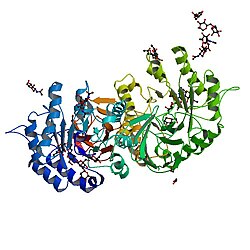α-galactosidase A
| Α-galactosidase A | ||
|---|---|---|

|
||
|
Existing structural data : 1R46 , 1R47 , 3GXN , 3GXP , 3GXT , 3HG2 , 3HG3 , 3HG4 , 3HG5 , 3LX9 , 3LXA , 3LXB , 3LXC , 3S5Y , 3S5Z , 3TV8 , 4NXS |
||
| Properties of human protein | ||
| Mass / length primary structure | 48.7 kilodaltons / 429 amino acids | |
| Secondary to quaternary structure | Homodimer | |
| Identifier | ||
| Gene names | GLA ; GALA | |
| External IDs | ||
| Drug information | ||
| ATC code | A16 AB03 | |
| DrugBank | DB00103 | |
| Drug class | enzyme | |
| Enzyme classification | ||
| EC, category | 3.2.1.22 , glycosidase | |
| Response type | Hydrolytic cleavage of terminal α- D- galactose residues | |
| Substrate | Galactose-containing oligo- and polysaccharides | |
| Occurrence | ||
| Homology family | alpha-galactosidase precursor | |
| Parent taxon | Eukaryotes | |
| Orthologue | ||
| human | House mouse | |
| Entrez | 2717 | 11605 |
| Ensemble | ENSG00000102393 | ENSMUSG00000031266 |
| UniProt | P06280 | |
| Refseq (mRNA) | NM_000169 | NM_013463 |
| Refseq (protein) | NP_000160 | NP_038491 |
| Gene locus | Chr X: 101.4 - 101.41 Mb | Chr X: 134.59 - 134.6 Mb |
| PubMed search | 2717 |
11605
|
α-Galactosidase A (also melibidase ) is an enzyme that catalyzes the hydrolysis of the glycosidic bonds of α-galactopyranosides. It occurs in all eukaryotes and has different specificities depending on the task and organism. For example, some α-galactosidases can also hydrolyze α- D- fucopyranosides. The enzyme is found in cells in the lysosomes .
Diseases
If the enzyme is not sufficiently available, the glycosphingolipids accumulate , which ultimately leads to the death of the cell. If the deficiency in α-galactosidase is caused by a genetic error, it is referred to as Fabry's disease . This is an X-linked inherited metabolic disease , wherein an organism further deficiency of the enzyme occurs.
Expression
The GLA - gene consists of a total of about 12,000 base pairs . Seven exons with 1290 base pairs code for the gene product α-galactosidase A. Its precursor protein consists of 429 amino acids . By post-translational modification of the produced glycoprotein α-galactosidase A with 370 amino acids and a molecular mass of 41.4 kDa . The homodimer , like all lysosomal enzymes co-translationally, that is, during the translation of mRNA into amino acid sequence , having a mannose-6-phosphate formed radical. A portion of phosphorylated α-galactosidase A molecule is from the cells secreted and other cells via the membrane-bound mannose-6-phosphate receptor by endocytosis added. The resumption of phosphorylated α-galactosidase A via the mannose-6-phosphate receptor is the basis for enzyme replacement therapy.
history
In the early 1980s, Goldstein at the New York Blood Center was the first to research the technique of changing blood types using glycosidases . Α-Galactosidase obtained from coffee beans (coffea canephora) was used to change red blood cells of blood group B to red blood cells of blood group 0. In 2008, however, there is still a considerable need for research in order to make this process clinically useful.
Individual evidence
- ↑ DF Bishop, R. Kornreich, RJ Desnick: Structural organization of the human alpha-galactosidase A gene: further evidence for the absence of a 3 'untranslated region. In: PNAS. Volume 85, Number 11, June 1988, pp. 3903-3907, PMID 2836863 . PMC 280328 (free full text).
- ↑ A. Gal, E. Schäfer, I. Rohard: The genetic basis of Fabry disease. In: A. Mehta, M. Beck, G. Sunder-Plassmann (Eds.): Fabry Disease: Perspectives from 5 Years of FOS. Chapter 33, Oxford PharmaGenesis, 2006, ISBN 1-903539-03-X , PMID 21290673
- ^ DH Calhoun, DF Bishop et al. a .: Fabry disease: isolation of a cDNA clone encoding human alpha-galactosidase A. In: PNAS. Volume 82, Number 21, November 1985, pp. 7364-7368, PMID 2997789 . PMC 391345 (free full text).
- ^ MW King: Introduction to Fabry Disease. Status: February 13, 2011, accessed on September 1, 2011
- ↑ Martin L Olsson, Cheryl A Hill, Humberto de la Vega, Qiyong P Liu, Mark R Stroud, Jean Valdinocci, Steven Moon, Henrik Clausen, Margot S Kruskall: Universal red blood cells — enzymatic conversion of blood group A and B antigens . In: Transfusion Clinique et Biologique . tape 11 , no. 1 , February 2004, p. 33 , doi : 10.1016 / j.tracli.2003.12.002 , PMID 14980547 .
- ^ Martin L. Olsson, Henrik Clausen: Modifying the red cell surface: towards an ABO-universal blood supply . In: British Journal of Hematology . tape 140 , no. 1 , October 26, 2007, p. 3–12 , doi : 10.1111 / j.1365-2141.2007.06839.x , PMID 17970801 .
